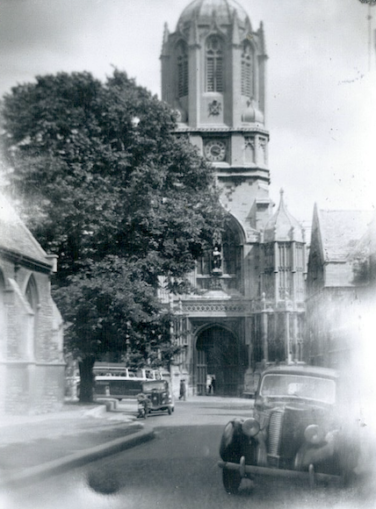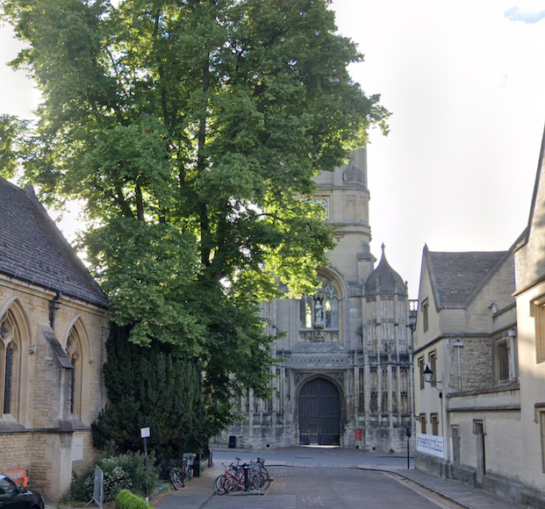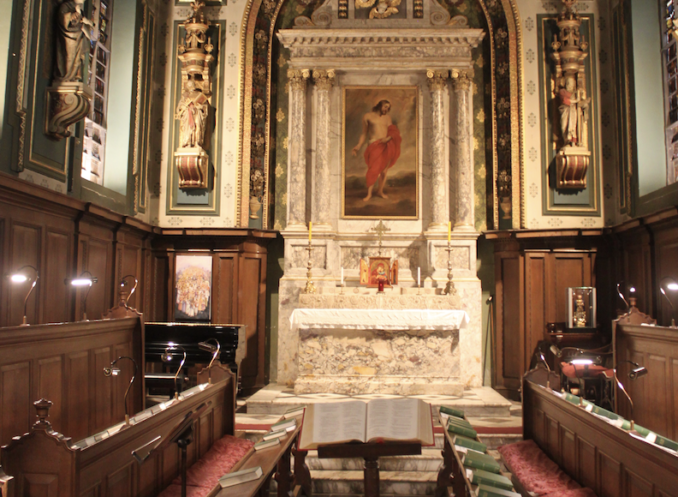The 1949 page of our old family photo album is confidently captioned ‘Bournemouth’ but neglects any images of the Hampshire Riviera resort. Not to worry. They say that getting there is half of the fun and seven decades ago they were correct – even for the motorist.
The photographic evidence shows en route my grandparents visited Oxford before the days of, and I quote, ‘100-day permits per calendar year per vehicle. Maximum one vehicle per person (must be the registered keeper or owner). Maximum three vehicles per household. Valid for all six traffic filters at any time during that day.’
Not only was there none of that nonsense in Oxford in those days but my grandparents were even able to park up and take a picture of one of the colleges – easily recognisable as Christ Church.
Christ’s

© Always Worth Saying 2023, Going Postal
Christ Church College is the largest college of the University of Oxford. Founded in 1546 by King Henry VIII and Cardinal Wolsey, it holds a unique position as a joint foundation of the university and the cathedral of the Oxford diocese. It was intended to be a grand institution that combined a college for students and a cathedral for the Church of England. However, Cardinal Wolsey fell out of favour with the king, and the college was taken over by Henry VIII.
Under Henry VIII’s control, the college was refounded as Christ Church College. The king wanted it to be a symbol of the new Church of England and the English Renaissance. The college was given extensive lands and properties, including the site of the suppressed Augustinian priory of St. Frideswide. This priory became the foundation of the college.
The original buildings of Christ Church College were constructed between 1525 and 1529 by Cardinal Wolsey. These buildings, including the Great Hall and the Tom Tower, still stand today and are iconic landmarks of the college. Throughout its history, Christ Church College has been closely associated with the Church of England and has produced many prominent clergy members. It has also been a centre of learning and scholarship, attracting notable students and scholars.
Today, Christ Church College remains one of the largest and most prestigious colleges in the University of Oxford and continues to be an important institution for both education and the Church of England.
The college is renowned for its connections to Harry Potter and Lewis Carroll. Many scenes from the Harry Potter films were shot at Christ Church, including the Great Hall which was replicated in the film studios. Lewis Carroll, the author of Alice in Wonderland, studied and taught at Christ Church, drawing inspiration from the college for his stories. Located in the heart of Oxford, Christ Church is easily accessible and offers guided walking tours that showcase its rich history and architectural beauty. It is advisable to check the opening times and admission charges before planning a visit.

© Google Maps 2023, Google licence
Refreshingly for once in our modern-day Street View comparison, there are fewer cars and more bikes than in the old days. You can have a look around here. However, we are missing a bus. In the older photo, Eagle-eyed Puffins will already have noticed a single-decker sitting between a tree and a car in the distance.
Oxford Busses
A row of bus stops sits outside Christ’s to this day along the A420 St Aldate Road which runs at right angles to Pembroke Square from where the old photo was taken.
I wouldn’t pretend to be an expert on such things but reference to the internet suggests the vehicle might be an AEC Regal with Duple coachwork. Look at the curve of the roof and the shape and size of the frontmost windows. Likewise the fuel cap in the middle of the coachwork below the lettering. Or it might not be. The BMMO C1 coach looks much the same.

A 1948 BMMO C1 Coach,
Defacto – Licence CC BY-SA 2.0
Puffins who really need to know might think about visiting the Oxford bus museum. Yes, not only is there such a place but it incorporates the Morris Motors Museum. Based a few miles north of the city, their Long Hanborough depot tells the story of bus and coach travel around Oxfordshire over the last 130 years. Exhibits include an historic preserved horse-drawn tram, motor buses, coaches and a wide selection of artefacts – including bus stops, ticket machines, timetables, posters and staff uniforms. Their website also boasts of fantastic photos illustrating Oxford’s diverse public transport history through the ages.
Tom Tower
The dreaming spire of academe in the distance is the Tom Tower, a prominent landmark located at the entrance of Christ’s. It was designed by Sir Christopher Wren, the renowned English architect, and completed in 1682. The tower is named after its bell, Great Tom, which weighs over six tons and is one of the largest bells in England.
Tom Tower is an exquisite example of English Baroque architecture, with its intricate detailing, decorative elements and iconic copper-clad dome. The tower serves as the main entrance to Christ Church College and provides a stunning view of Oxford from its upper levels.
The tower’s design incorporates a mixture of classical and Gothic elements, reflecting Wren’s unique style. It features ornate carvings, statues and a clock with four faces which, apparently, tell the wrong time. The good people of Oxford being brainy, upon the discovery (invention?) of Greenwich Mean Time they overthought the consequences and set their clock five minutes behind Greenwich to take into account the difference in longitude between the two. The tower’s dome is topped by a gilded weathervane in the shape of a crown, symbolizing the royal connection of the college.
Tom Tower has historical significance as well. It is believed that its construction was partly funded by the proceeds from the dissolution of the monasteries under King Henry VIII. The tower stands as a symbol of the college’s rich history and its association with the Church of England.
Visitors to Oxford often admire Tom Tower for its architectural beauty and historical importance. It is a popular subject for photographs and a recognizable symbol of Christ Church College and the city of Oxford as a whole.
Pembroke Square itself is named for Pembroke College which is the building to the right in both photos.
Pembroke
One of the constituent colleges of the University of Oxford, Pembroke was founded in 1624 by King James I of England and Sir Thomas Tesdale, a wealthy London merchant. The college is located in the heart of Oxford, near Christ Church College and the Bodleian Library.
Pembroke College has a rich and diverse history. It has been associated with many notable individuals, including the poet Samuel Johnson, the Nobel laureate Sir Roger Penrose, and former prime minister and Puffin’s favourite Theresa May.
The college’s architecture is a blend of medieval and modern styles. The oldest surviving building is the medieval chapel, which dates back to the 14th century. Other notable buildings include the Christopher Wren-designed Hall and Chapel Quad, as well as the modern Nuffield Building.
Pembroke College, where Tolkien once walked, is also known for its friendly and inclusive atmosphere. It has a strong academic reputation, offering a wide range of courses across various disciplines. The college also provides a supportive community for its students, with numerous extracurricular activities and societies.
The college is open to visitors, who can explore its historic buildings and learn about its rich heritage. Guided tours, led by knowledgeable college members, offer insights into the college’s history, architecture, and academic life.
Overall, Pembroke College is a vibrant and intellectually stimulating institution within the University of Oxford, providing a nurturing environment for students and contributing to the academic and cultural life of the university.

A view from the entrance of Pembroke College Chapel,
Medarduss – Licence CC BY-SA 4.0
St Aldate
St Aldate is the street on which Christ Church and Pembroke stand and which runs south from Carfax. It is home to the Town Hall and other notable attractions including Alice’s Shop, the University of Oxford’s Faculty of Music, the police station, and the Oxford Combined Court Centre. Beyond Folly Bridge, the street becomes Abingdon Road and leads out of the city.
To the left on our Oxford photos is St Aldate’s church, a historic Church of England parish church. It has a long history dating back to the Saxon era and has undergone various renovations and expansions over the years. The church has a large congregation and a staff team of about 30. It is known for its involvement in various ministries and encourages its members to be actively engaged in different areas of church life. The Catacombs building at 12 Littlegate Street has been converted into a youth centre and prayer room.
St Aldate’s has also organized the annual Love Oxford event, which brings together churches in the city for an open-air service. The church was featured in a Channel 4 documentary about the Alpha course. This all sounds a bit happy clappy. I shall retreat to my 1965 Attwater’s ‘Dictionary of Saints’ and research St Aldate the man. For once my much-thumbed encyclopedia of hagiography draws a blank as between St Albert The Great and St Aldhelm there sits naught.
Further research shows that Saint Aldate is thought to have been a bishop of Gloucester who died in 577 AD. His feast day is on the 4th February. As we discovered from Attwater, Aldate’s life is not detailed historically, but he is thought to be a Briton killed by the Anglo-Saxons at Deorham. According to Wiki, he is reported to have roused the countryside to resist pagan invasion forces with his (perhaps unreliable) biography being pieced together from the Sarum and other ancient martyrologies. Besides Oxford, a church is dedicated to him in Gloucester.
Fourteen and half centuries later, locals are martyred by the traffic Nazis.
Happy New Year!
© Always Worth Saying 2024



